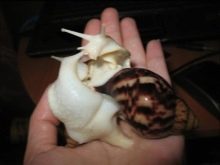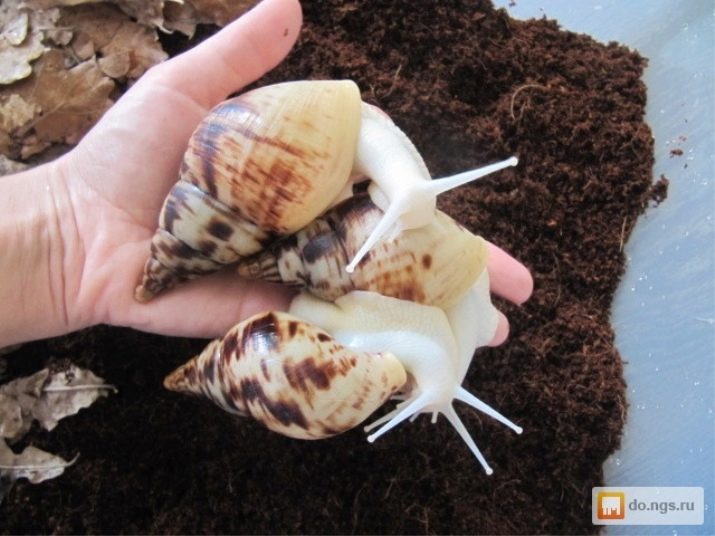In the XXI century, it became extremely popular to start quite unusual exotic pets: spiders, scorpions, lizards, snakes and even crocodiles. However, the listed reptiles and insects are either very dangerous or too unattractive. Having an irresistible desire to make such a "friend", you can do this without spending huge amounts of money and without experiencing feelings of disgust. We are talking about domestic snails. The most common mollusk for this is Achatina albino.
Origin and variety
The native land of the described mollusk is considered the tropical forests of Africa, Tanzania and Kenya. In wild conditions, snails are characterized by rapid growth and development. For 1-1.5 years, their sink can increase to 20 centimeters, so at home it looks unusual and attracts the attention of others. All mollusks that belong to the reticulate species have the same characteristic shell, painted in beige color with brown stripes and specks. By color, they are divided into 3 types.
- Standard is a snail that has a light body and a brown head.
- Blackhead is a snail that has a dark head and a body of light tone.
- Albino is a snail that has completely lost its pigment and is painted white.
Also today, there are other types of mollusks that are extremely popular (for example, immaculate, albopict, fulica, iridelia and others). These species are slightly different in structure or color from albinos, but the conditions of detention are the same for everyone.



Appearance and character
The head, body and sole of the Achatina albino snail are painted white or beige. The shell is brown with a ribbed surface. Often it shows stripes or spots of a darker shade.The shell for all mollusks is the most precious element, with serious damage to which the snail is most likely to die. A shell can reach a size of 20 centimeters, and a body up to 25 centimeters. Albinos grow slower than other species of mollusks, therefore, in size, they also lag behind their counterparts.
Achatina albino is a very friendly and active creature. He always makes contact with people and loves to play. The head is always stretched forward, because it is very curious and wants to keep abreast of all events. The snail, according to the owners, is distinguished by its intelligence and learning ability. It can be said with accuracy that the snail will become a good and beloved pet for you and your children. She does not bite or scratch anyone, does not smell at all and does not create noise.
In addition, there are no allergic reactions from snails, moreover, they are used in cosmetics.

Care and maintenance
Snails are extremely unpretentious in care. They do not require much attention and care. To maintain a favorable environment, a little effort and financial investment is needed. The first thing you will need to take care of is your pet's place of residence. You can buy a special terrarium for this, but if you suddenly have financial problems and you don’t want to spend money, you can use an old aquarium or even a food container. The use of cardboard or plywood for the home of a snail is not allowed.
Mandatory requirements for comfortable living in a "snail house":
- the presence of a cover with the possibility of air exchange;
- transparent walls;
- the shape of the container should not be round;
- environmentally friendly material.
If you opted for a terrarium, then you definitely need to have some information. These devices come in horizontal or vertical designs. The most convenient form is horizontal. In the finished container from the pet store, everything is already thought out for you: mount for a thermometer and a hygrometer, ventilation and so on. The only significant minus is the price, but it will depend on the materials from which, in fact, the terrarium is made.

Most beginner lovers of African snails first choose an aquarium. It is important that it has a rectangular shape and a volume of at least 20 liters, provided that 1 individual lives there. If you have much more snails, then there will be much more space. Here, you yourself will have to equip ventilation for active air exchange, as well as a lid to prevent snail escape. Unfortunately, the aquarium has many disadvantages, for example, it is extremely fragile, heavy, and inconvenient to use.
Today, a food container is gaining more and more popularity among buyers. It is made of environmentally friendly materials and has fairly durable characteristics. There are options with transparent walls, making it possible to observe the lives of these little friends.

Every organism living on our planet needs fresh air. Today, there are 2 statements about ventilation for snails. The first is that a few holes are enough for the mollusk to allow the air to renew and dry the soil, preventing it from becoming moldy. The second defends a more correct position of forced ventilation, since it is important that the air not only enters, but also exits. Thus, you should make holes like this:
- in one of the walls - at ground level;
- in the opposite wall - right under the lid.
- the holes should be no wider than the match head.
Do not forget that the snails are contraindicated in direct sunlight, therefore it is better to place the house for snails on any shelf. Also avoid drafts, which is also very dangerous for small residents.


Soil, which is suitable for snails, may have several options.
- Coconut substrate is the most common and inexpensive soil.A litter that absorbs moisture well and does not stain the terrarium.
- Peat is also a fairly common soil. It is advisable to use in combination with other soils.
- Moss is the most accessible type of soil. It absorbs moisture well and prevents the propagation of annoying midges. It serves as a kind of indicator of humidity in the aquarium.
- Earth is a great soil in which snails feel great.
- Leaf litter is both independent and additional soil.
It is strictly forbidden to use sand as a litter, as it scratches the sink and clogs the digestive system, which can lead to the death of mollusks. Stones are also forbidden because the snail can break on such hard ground. It is advised to avoid using sawdust and clay as soil.



It is equally important to maintain the temperature for a comfortable stay. Due to the fact that snails come from a hot country, the temperature should be in the region from 24 to 29 degrees. To create and maintain such a regime, an incandescent lamp or a thermal cord is used, but in no case is the house placed next to heating appliances. This negatively affects the health of snails.
Do not forget about humidity. Normal moisture levels are 70-90%. To do this, it is necessary to spray the soil 1-2 times a day with warm water, while not over-moistening the space.
To create coziness, the terrarium can be decorated. So, inside you can add a piece of bark, moss, a few cones and even a coconut shell. In addition, you can plant live plants, for example, fern, young trees, money tree, ivy and other vegetation. Over time, the plants will have to be updated, as the residents of the house will sometimes feed on them.


Feeding
Usually the snail is fed 1 or 2 times a day. Shellfish are unpretentious in food and eat almost everything. If necessary, they can tolerate weekly hunger. It should be remembered that the inhabitants need additional minerals and vitamins, so you can put chalk stone in the aquarium. Some chop shells and add to food to strengthen shells.
Food:
- greens (lettuce, broccoli, parsley, spinach and more);
- vegetables (potatoes, tomatoes, carrots, cucumbers, zucchini, pumpkin);
- fruits (apple, pear, banana, melon and so on);
- berries (raspberries, watermelon, strawberries, raisins and much more);
- wild vegetation (clover leaves, plantain);
- cereals (buckwheat, rice, pearl barley, hercules, corn flakes).
The house must have a container of water. She will use it not only for drinking, but also for the adoption of water procedures. It is important to consider that the bowl is not deep. Water needs to be replaced as it gets dirty.


Breeding
Achatina albinos live in pairs and are hermaphrodites, that is, both individuals lay eggs. The masonry should be carefully monitored, and the kids should live separately from adults, as they can cause enormous damage to the parent's sink. And, most likely, there will be not enough space.
An individual begins to lay eggs from a year old. She can bring up to 300 eggs at a time. If the owner has so many larvae unnecessarily, then some of them are frozen and grinded, and then fed as an additive to enhance health and shell. Small snails appear on the tenth day or a little later. They must be kept separately from adults until their shell grows to 4 centimeters.

You can look closer at this type of snail further.










